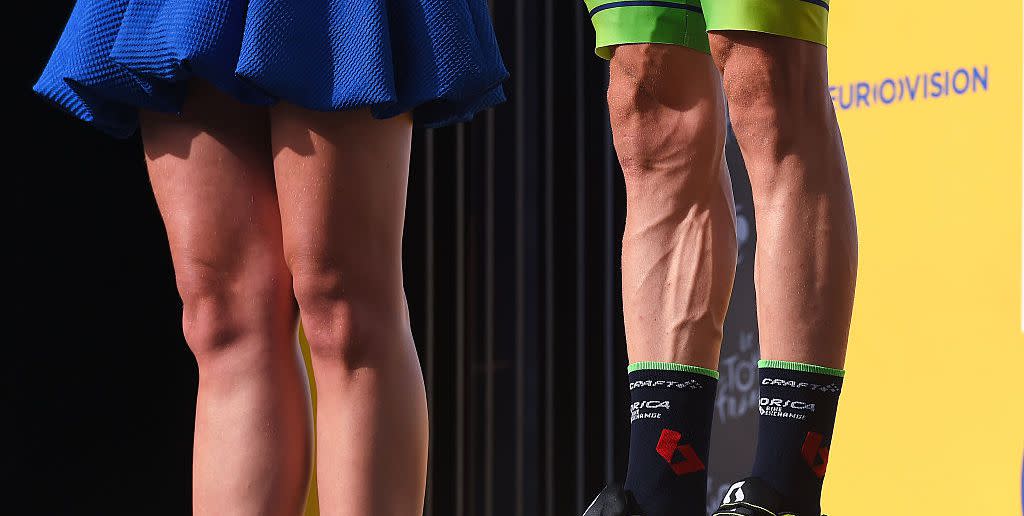Uh, So What's the Deal With Tour de France Riders’ Legs?

Vascular legs on pro cyclists are typically the result of a combination of low body fat and higher blood volume due to exercise.
Expert Debabrata Mukherjee, M.D., says that pro cyclists have twice as much blood flow to their legs, compared to recreational cyclists.
If you train more, you’ll likely notice more visible veins, but it’s unlikely your legs will look like these pros. Leg aesthetics, including carved calves, can also largely depend on genetics.
Back in 2017, Bora-Hansgrohe rider Pawel Poljanski almost broke the Internet after Instagraming a photo of his “tired legs” following stage 16 of the Tour de France. This left everyone wondering what is really going on with these crazy post-Tour de France legs.
After sixteen stages I think my legs look little tired 😬 #tourdefrance
A post shared by Paweł Poljański (@p.poljanskiofficial) on Jul 18, 2017 at 10:04am PDT
The sprawl of veins punching through his paper-thin skin looked like a host of spiders throwing a web-weaving rave. Heck, even my mom reposted it asking, “Does this hurt?!” Other slack-jawed observers wondered if such a vascular look was worth aspiring to or whether Poljanski was simply a freak of nature.
And Poljanski isn’t the only one. Team INEOS (formerly Team Sky) shared a dramatic photo of Chris Froome’s legs back in 2014, and Antoine Duchesne also shared a photo of his after training for the Tour before missing the selection in 2017.
Our man @chrisfroome is looking absolutely ripped ahead of #LBL on Sunday! (Photo: @michellecound) #VaVaFroome pic.twitter.com/UGePCkvwKU
- Team INEOS (@TeamINEOS) April 23, 2014
Quand tu te préparais pour le Tour et que finalement t'as perdus 5kg....🤢💩#tdf2017 #sec https://t.co/RRNJbUMqL8 pic.twitter.com/fGlbhKitKE
- Antoine Duchesne (@tonythetiger_1) June 27, 2017
Almost every year, a similar photo from a pro cyclist on the Tour pops up. And while these photos are jarring, vascular legs don’t actually hurt (though the efforts to get there usually do). As for the rest of the questions, we tapped vascular expert Debabrata Mukherjee, M.D., chair of the department of internal medicine and chief of cardiovascular medicine at Texas Tech University Health Sciences Center in El Paso, to find out what’s really going on here.
Related video: Lawson Craddock Rides on After Crash in Stage 1 for an Awesome Cause
“These prominent veins are due to a combination of low body fat and significant increase in blood that flows through the legs of high-level cyclists,” Mukherjee says. Tour de France riders have minimal body fat, so there’s no soft layer under the skin to mask the veins, which are essentially sitting closer to the surface.
“High-level cyclists also have double the blood flow to their legs compared to recreational exercisers,” he explains. So while you may have about 20 liters a minute coursing through your pistons as you ride, a pro like Poljanski pumps around 40 liters a minute through his pedal pushing muscles. “That contributes to bulging prominent veins,” Mukherjee says.
And if those metabolic changes don’t pump you up enough, blood pressure increases during exercise can force plasma fluid out of your thin vessel walls and into compartments surrounding your muscles. This process, known as filtration, causes swelling and hardening of the muscle, which nudges all those bulging veins even further to the skin’s surface.
Should you aim to create your own vascular network to share on your social network? Not necessarily. Though they may get a lot of attention, prominent veins in and of themselves are not particularly beneficial, and like diamond carved calves and second knee cap quads, not every rider is genetically wired to achieve the same aesthetic. That said, Mukherjee says a few more veins rising to the surface is definitely an indicator of improving fitness or decreased body fat.
“Since it reflects lower subcutaneous fat and higher blood volume, the harder a cyclist trains, the more prominent the veins will become,” he says. “It is something that may tell an athlete that he/she is getting to a higher level of performance.”
[Related: How to Shave Your Legs Like a Total Pro]
('You Might Also Like',)

